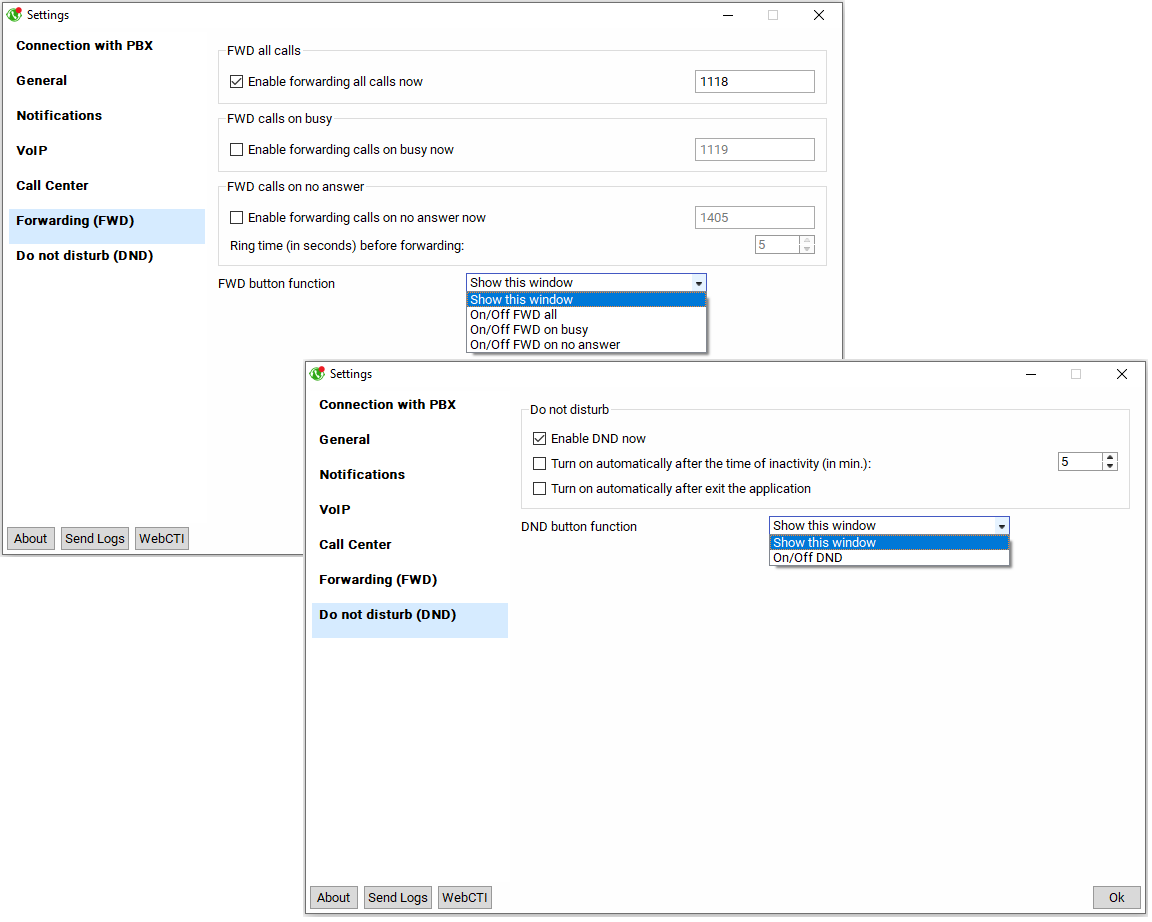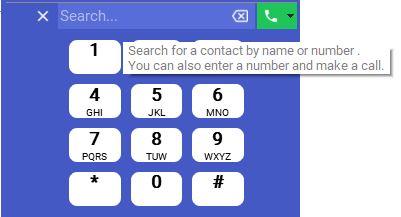MessengerCTI.desktop v 1.07 Manual

Contents
Introduction
Slican MessengerCTI.Desktop is software which purpose is to assist users of Slican PBX. Thanks to the graphic interface displayed on the computer screen, software allows for convenient access of telephone calls and other functions related to it. Software delivers additional features that allows to expand capabilities of desk phone. Software combines capabilities of controlling desk phone connected to PBX, for example choosing number, receiving calls and also application is able to function as standalone phone. Software also allows to: accessing PBX's phonebook, call history, status of phone and other users of MessengerCTI, text communication and sending or receiving SMS messages. Additionally for new version of DPH.IP doorphone equipped with camera - video preview was added.
Application works with all types of phones connected to Slican PBX: CTS system phones, analogue or VoIP phones. In the most recent firmware version of PBX (6.53 IPx, 1.11 NCP) MessengerCTI can work as standalone VOIP phone. Depending on type of used phone usage of application slightly differs. While using CTS system phone, device is integrated with software, calls can be controlled with turning on speakerphone (choosing number, connecting, picking up or disconnecting call). On FXS and SIP phones, these activities always involve physically picking up phone handset. Nevertheless, users of FXS phones will undoubtedly benefit the most, because they gain access to functions completely unavailable for this class of phones.
Using cameras and DPH.IP doorphones
Introduction to sale of DPH.IP doorphones that include cameras allowed to solution that allows display of video from these cameras. Functionality was added with MessengerCTI.Desktop. While connecting to doorphone from software video from camera will appear in new window on computer display. After starting call and next finishing call, even after without talking to person standing beside doorphone, just after visual check user can open door, gate, barrier using dedicated button. Reverse is also true, calling to doorphone or another telephone associated with camera, computer display will show video from their cameras. This allow for temporary observation of neighborhood of installed camera, for example person we are calling. There is also option of watching video from any camera without making call, just using application icon. Thanks to MessengerCTI.Desktop user can preview video from camera of other manufacturers but those devices have to support video formats, codec compatible with VLC application libraries.
VoIP Client
MessengerCTI.Desktop can work as VoIP, parallel phone connected to desk phone (FXS,CTS,IP). User can decide on which device to pick up a call, phone or computer - using it's integrated audio devices (sound card, microphone, speakers or external headphones). Since 1.11 version of NCP firmware application can be used as standalone SIP phone. For such configuration CTIuserPlus license is required.
Phone Book
Big advantage of software is simple and convenient access to contact from phone books and displaying them on computer screen. MessengerCTI.Desktop can use only phone books from PBX. Contacts can be sorted according to user needs. Adding new subscribers and modification of existing entries can be done from CTS system phone or more conveniently, by using computer with MessengerCTI.Desktop or WebCTI. Modification of entry is visible instantly after adding it. Access to phone book allows to simply search numbers of contacts user want to call. On other hand, during incoming calls computer displaying will be showing clear information about calling person.
Call History
User has access to complete history of their calls, picked up and missed one. History is saved on Slican PBX. By using Messenger.CTI history can be displayed alongside information about order, time of calls and number of missed calls from particular number.
CallCenter (NCP PBX)
In conjunction with NCP for Call Center agents, queue handling functionality has been introduced. It allows agents to log in to them, view status, call back lost and abandoned calls, and turn on status of temporary work breaks.
Text messages
With use of MessengerCTI text information can be sent, from internal messenger(chat) through a computer network to another Messenger CTI.user, also as SMS message to another phone and from GSM phone. Chat can be accessed by all users of particular PBX and all PBXs linked to it by eSSL ver.2. This functionality is suitable for companies which obtained Slican PBX and doesn't allow use of public messenger applications because of security reasons.
Listening to recordings
Each user with appropriate permissions can listen to call recordings. In this way, it makes it independent from need to use RecordMAN.client application
Signaling encryption (NCP PBX)
In order to increase security of sending sensitive data, possibility of enabling encryption has been introduced. XML signaling stream is encrypted. (SIP acoustics and signaling are not encrypted)
File transfer (NCP PBX)
Possibility of sending files, documents, photos between users of MessengerCTI application has been introduced. Additionally, user can use clipboard to synchronize their files between MessengerCTI.Desktop and Mobile version
Works with mobile version
Application can be used alongside and synchronized to MessengerCTI.Mobile, Android version for mobile devices.
Minimum requirements
To install SLICAN MessengerCTI.Desktop application, following minimum requirements must be met:
- CPU Frequency - 800 mhz or higher
- Ram - 1 GB or more
- GPU- compatible with DirectX 9
- Operating System - Windows 7 or more recent
Application can be installed on computer which doesn't meet minimum requirements but it will run slowly or some option won't work correctly.
|
Installation of application
Usage of MessengerCTI.Desktop is licensed so purchasing appropriate license is required. Purchased code can be entered during configuration of PBX, code determines number of devices that can use software. Licensing doesn't affect software installation. Installation file of software can be downloaded from ServNET [1] and installed on Windows computer. After installing, application should be properly configured by entering necessary PBX information to which software should be conencted: Settings - Connection with PBX.
|
Second stage (optional) consists of uploading to PBX prepared file containing MessengerCTI.Desktop application. It can be done by PBX administrator who has WebCTI administrator privileges. This action allows automatic updating of software on devices. Update has been described in section "Updating application"
Running application
MessengerCTI.Desktop can be run just as any other Windows compatible software. In program settings automatic start during launch of operating system can bet set. During start of program it is logging to PBX (according to settings set in Settings - Connection tab). After successful login program data is synchronized with PBX data.
Updating application
Software update is automatic and user can't affect this process. Just like updating firmware of BPX, VoIP expansion card or REC card MessengerCTI.Desktop is also updated (by PBX administrator). During each startup of program, program version is compared to version on PBX. If they differ, version from PBX is automaticaly downloaded, installed and logged to PBX. Depending on version from PBX it may install newer or old version.
Available configurations
- Simultaneous operation of desk phone and application (application VoIP mode is turned off) - calling with phone, application - dialling up outgoing calls for phone (CTS, FXS, SIP) and picking up incoming calls for phone (CTS)
- Simultaneous operation of desk phone and application (application VoIP mode is turned on) - independent choice of picking/dialing up call with phone or application.
- Autonomous application without desk phone (application VoIP mode on) - picking/dialling calls only with application.
Other functionalities, for example: chat, sending and receiving SMS, displaying video from camera, accessing call history and phone book, configuring user status and Messenger aplication are available for each of above configurations.
Application MessengerCTI.Mobile is intended for mobile devices with Android system, its description can be found HERE(manual in progress).
MessengerCTI.Desktop with paralell setup
Application with VoIP mode turned OFF
Phone calls (transmitting accoustic) are made only using phone working alongside application. Application allows to:
- for outgoing calls - searching for number in phone book or typing phone number using computer keyboard, initiating dialling, dialling with phone speaker using CTS phone
- for incoming calls- displaying caller phone number in window or caller name from phone book of PBX, pickup up incoming call on speaker phone using CTS phone.
For user of FXS nad SIP phones picking up handset is necessary.
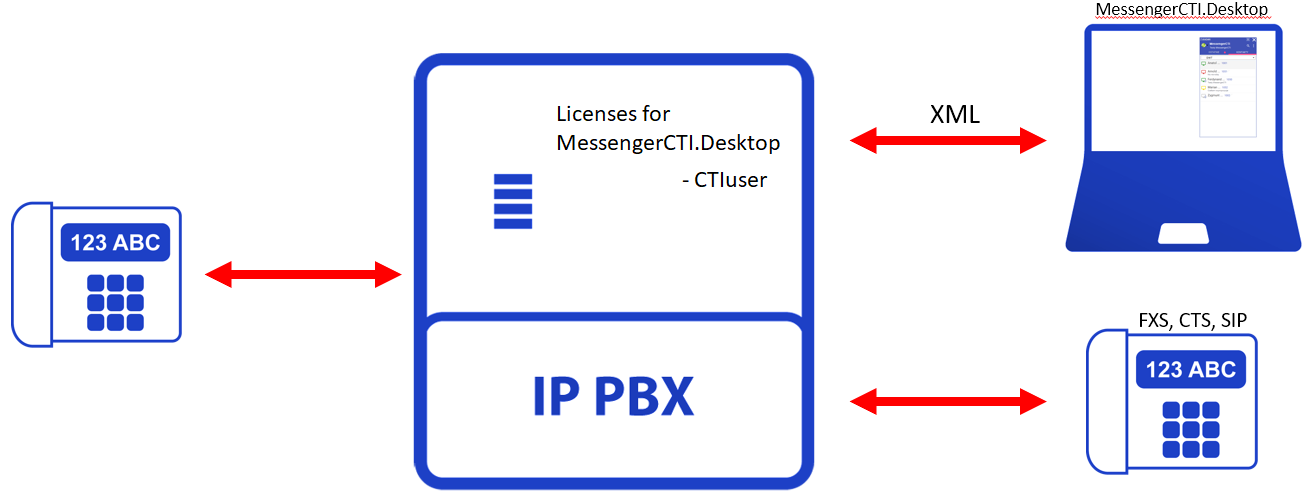
Application with VoIP mode turned ON
Phone calls can are made with phone or with computer and application. Application allows to:
- for outgoing calls - searching for number in phone book or typing phone number using computer keyboard, initiating dialling, calling while using computer microphone and speakers or external headphones
- for incoming calls - triggering sound of incoming call, displaying calling number/name from phonebook, picking up call with computer microphone, speakers or external headphones.
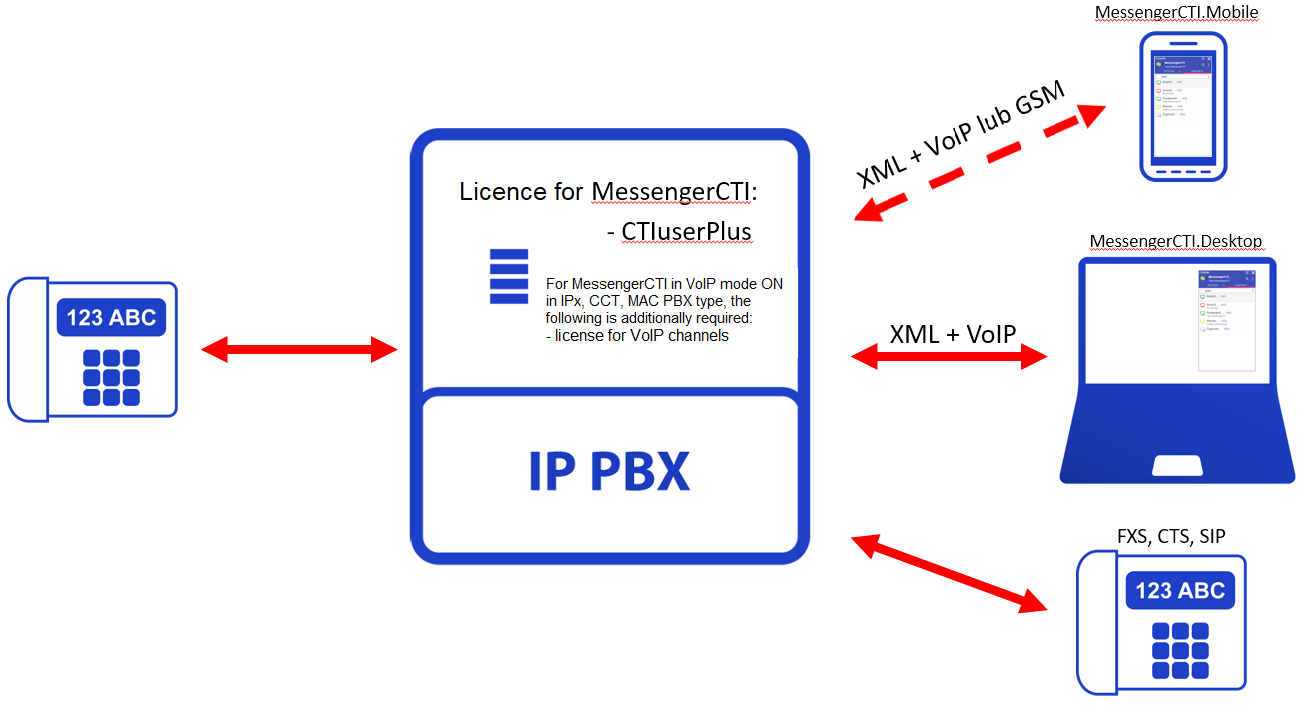
MessengerCTI.Desktop working as deskphone (with NCP only)
Application with VoIP mode turned ON
Phone calls are made only with computer and application. Standalone applications allows:
- for outgoing calls - searching for number in phone book or typing phone number using computer keyboard, initiating dialling, calling while using computer microphone and speakers or external headphones
- for incoming calls - triggering sound of incoming call, displaying calling number/name from phonebook, picking up call with computer microphone, speakers or external headphones.
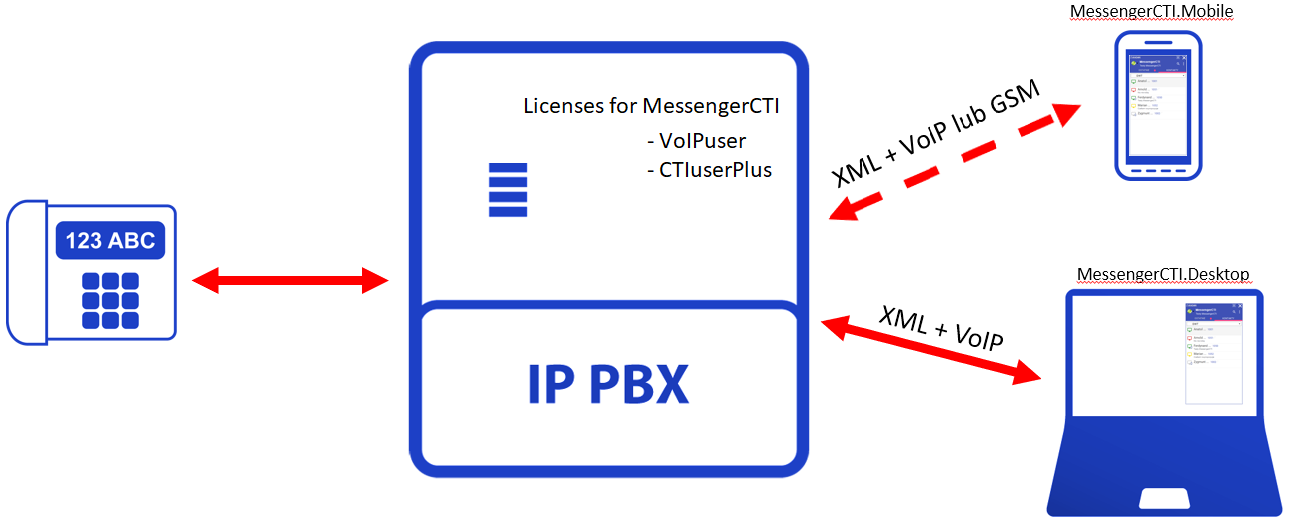
Application structure
Main window
Main windows of MessengerCTI.Desktop application contains interface which show information and allows access to chat windows and main functions.
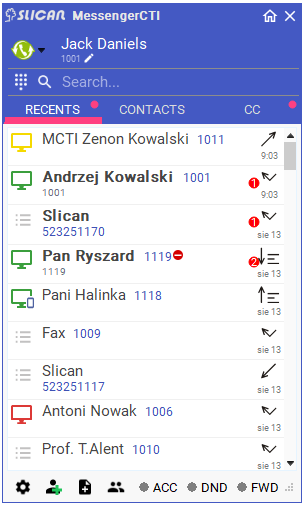
Top panel
- hyperlink to software version
- application name
- default window position button
- close - minimizing to tray button
- changing application status button
- user name from Contacts
- description - editable comment field set by user that allows him to add additional descriptive information, e.g. inform about upcoming or being on vacation, about dealing with selected project
- keyboard - button to open keyboard for dialing numbers with computer mouse
- magnifier/search - button / field for searching for number or subscriber's name
- access to tabs:
- Recent - history of most recent calls and messages
- Contacts - phonebook from PBX with sorting options
- red dot - information:
- about missed calls
- about calls to be called back in CallCenter
Bottom panel
- preferences - access to program settings
- add contact
- add to clipboard - sending messages and files between user MessengerCTI.Desktop and MessengerCTI.Mobile
- creating text conference
- ACC - subscriber's account login
- DND - configuration/ activation of "Do Not Disturb" service
- FWD - configuration/ activation of "Forward" service
- change size of window
Status of application and user
MessengerCTI.Dekstop software allows to show current status of user with coloured symbol and display it inside applications of other users. Applications status is informing about user availability, depending on user actions status can be changed by him or application can change it automatically. More information can be added through text status of user. User can choose different icons/symbol to set his status manually. Additionally there is graphic informing about ringing phone or current call.
List of icons and symbols
Chart presents list of icons available in Contacts and Recent tabs:
-
 - for internal PBX users - different icon color represent current applications status. It can be set manually through main application window, by icon
- for internal PBX users - different icon color represent current applications status. It can be set manually through main application window, by icon  , also is set automatically for Be right back status.
, also is set automatically for Be right back status. -
 - for public subscribers.
- for public subscribers. -
 - for DPH.IP doorphones connected to open/closed door sensor
- for DPH.IP doorphones connected to open/closed door sensor
Chart 1: Meaning of icon status of application, users and doorphones.
Chart is showing list if icon that appear on the left side of subscriber name in tab Contacts and Recent. Internal phone will have status icon being displayed
Settings
Selecting Open settings icon ![]() in main program window will display window with program settings. In every tab there is available button with info About software with information about version application and link to user's WebCTI account.
in main program window will display window with program settings. In every tab there is available button with info About software with information about version application and link to user's WebCTI account.
Connection
In Connection field you must enter settings neccesary for application to connect:
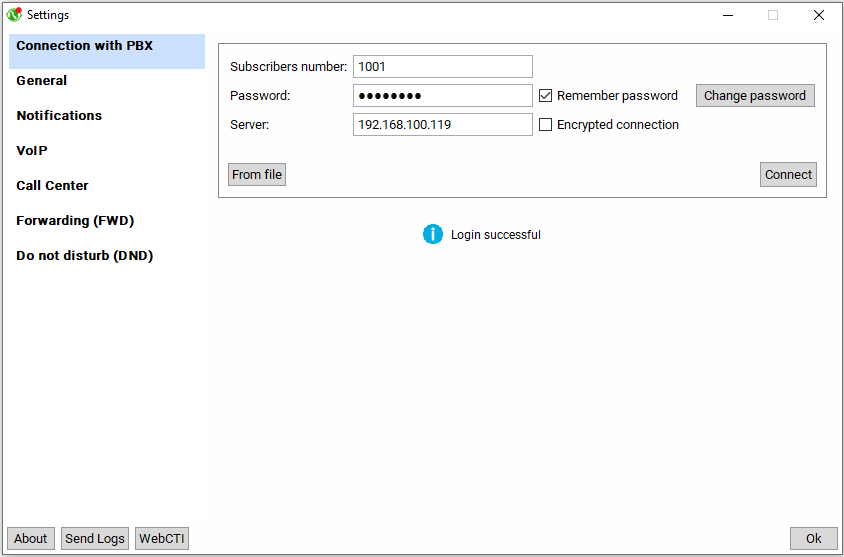
Application login setting
To login, application must have correct settings configured by PBX administrator:
- subscriber number - extension from PBX
- CTI access and password:
- for IPx, MAC, CCT - ConfigMAN chart Subscribers/CTI settings - CTI - access level to CTI and Pss - Password
- for NCP - ConfigWEB chart Extensions/Subscribers/CTI setting - Access to CTI and Password
- Server address - PBX network settings
CTI access level determines what options are available to application:
- CTI.user - MessengerCTI without VoIP and camera preview
- CTI.userPlus - MessengerCTI with VoIP and camera preview
These connections settings must be filled:
- Subscribers number" field - extension number for which MessengerCTI.Dekstop will login.
- Password field - defined CTI password (may contain from 4 to 16 characters, excluding ";" or "~"). After first application login to PBX password change may be necessary. Password can be remembered in application by putting tag in appropriate field (on right side of the password); if tag is not inserted, application will ask for it every time you log in.
- Server - IP address of PBX network interface. In case of application logging outside PBX network - IP address of edge router (port forwarding on router is necessary)
After correct configuration all of above fields, using "Connect" button will allow application to Connect with PBX and synchronize phone book and other information related to that extension. "Login successful" will apear in lower part of window.
If login credentials, configuration settings aren't correct or there are issue with network connection those error messages may appear:
- Wrong login or password. Check if correct login or password was used
- Connecting to PBX alternating with:
- No connection to PBX Check IP address that was entered and check computer LAN connection
In order to facilitate configuration of application, functionality of generating configuration files sent to user's e-mail box has been introduced in NCP PBX. After receiving e-mail, simply use From file button to select right file and application will log in to NCP automatically.
In case of problems with application - its stability, functionality, logging, etc. - after detailed description of irregularities, you can submit report using Send Logs button.
General
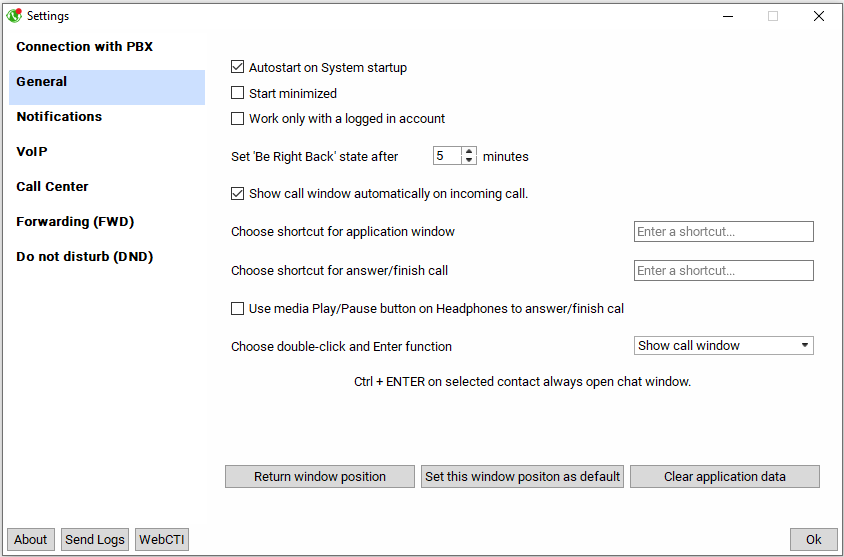
This window allows to configure settings defining how program works and startup options.
Available settings:
- Auto start on System startup - automatic start of application.
- Start minimized - application will run hidden in system task bar.
- Set "Be right back" state after x minutes - status icon will change automatically, informing about user being away from computer after defined time
- Show call window automatically on incoming call - Enables/ disables popup window when there is an incoming call
- Choose shortcut for application window - changes application from Windows task bar to desktop and vice versa
- Choose shortcut for answer/finish call - answer call/ end call with selected keyboard shortcut
- Use media Play/ Pause button on Headphones to answer/finish cal
- Choose double click and Enter function (for contact or number):
- show call window - choice windows is displayed with options - number, phone call, opening chat/SMS window, closing current window
- call primary number - automatic number dialling
- show chat window - opens text chat window
- Return window position - return to previous window position
- Set this window position as default - allows to set up default application's window potion on screen
- Clear application data - deletes all application configuration data, attachments, history
Notifications
These setting allow to set up audio notifications informing about incoming calls, messages and audio setting of computer audio devices.
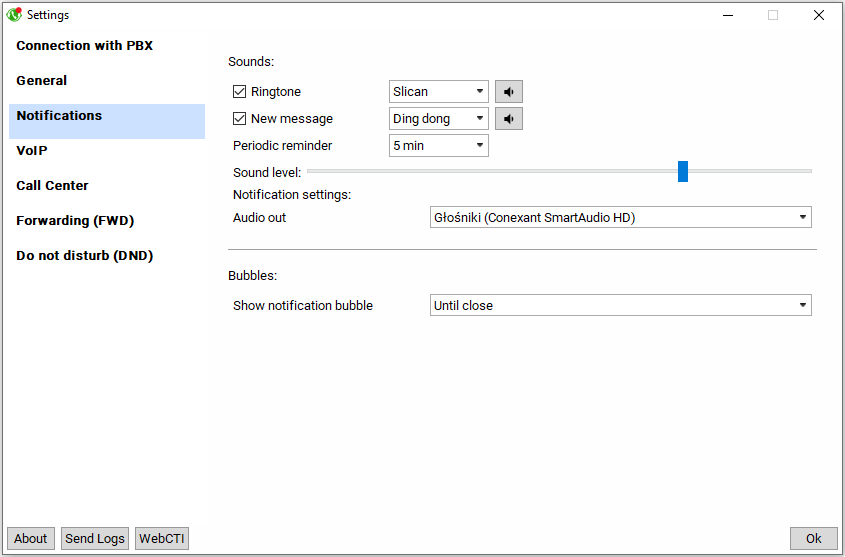
VoIP
- Enable VoIP on when available - allows application to work as VoIP client (VoIP phone). Advanced VoIP settings also allow to connect application with PBX on non-standard ports (e.g. from Internet to client's edge router, MAC PBX)
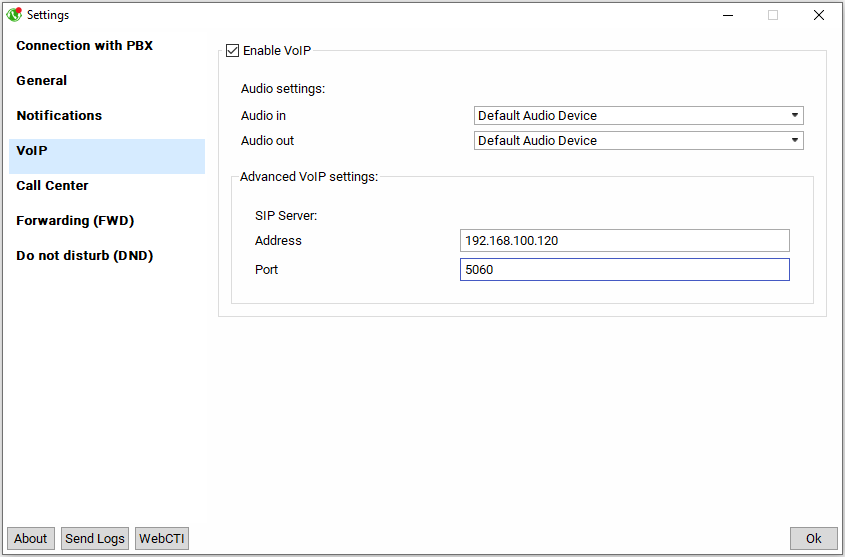
CallCenter
This window allows to configure some options related to agent's handling of CallCenter queues, e.g. buttons for logging in to one, many, all queues, buttons for agent breaks
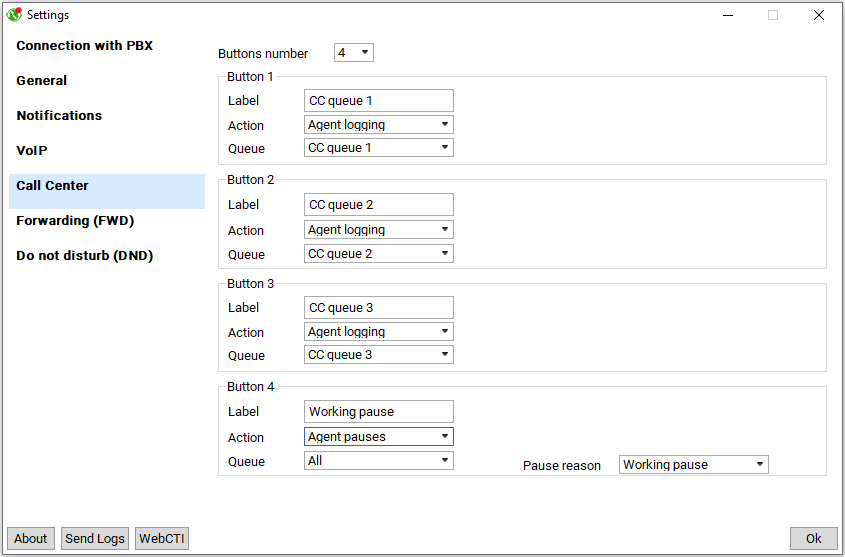
Services management
This window allows to configure Forwardings and DND services
